News consumption on mobile media surpassing desktop computers and newspapers
2013 RJI Mobile Media Research Report 1
Nearly 80 percent of all respondents to our 2013 Q1 phone survey said that they had used at least one Internet-enabled mobile media device in the seven days prior to taking the survey.
That represents a 13-percentage-point increase since last year when our survey found that two-thirds (67%) of all respondents between the ages of 18 and 88 had used mobile media devices.
The increase in the number of mobile media users was significant in every age group, but it was most dramatic in the 45-54 and 65-and-older age groups.
The number of respondents who said they used mobile media to keep up with the news also grew significantly in all age groups. More than half (55%) overall in 2013 were mobile news consumers compared to 42 percent of respondents overall in 2012.
The use of mobile media devices for news in 2013 was highest (70%) among those respondents who were between the ages of 18 and 44.
In our 2013 survey, we included additional questions about the use of desktop computers for accessing news stories.
In every age group except for those 65 and older, the percentage of respondents who used mobile media devices to keep up with the news exceeded the percentages of those who used desktop computers for news.
Again with the exception of those 65 and older, our survey found that a majority (59% to 77%) of desktop news consumers in every age group also were mobile news consumers. Our survey also found that mobile news consumers now make up a higher percentage of newspaper subscribers than desktop news consumers.
The rapidly increasing use of mobile media devices for news is undoubtedly contributing to the general decline in subscriptions to printed newspapers.
While the number of respondents who said they subscribe to newspapers this year fell by only two percentage points overall, the falloff was much more pronounced in all but the 65-and-older age group.
This age group, which includes a high percentage of retirees and a relatively low percentage of mobile news consumers, now has the most newspaper subscribers.
The aging of print news consumers is clearly evident in our survey results. Last year slightly less than half of the newspaper subscribers were age 55 or older. This year they accounted for 61 percent.
The use of mobile media for news has grown rapidly among newspaper subscribers in the past 12 months.
More than half (52%) of this year’s respondents who said they subscribed to newspapers also said they had used mobile media devices to keep up with the news. That represents an overall gain of nearly 15 percentage points since last year.
For newspapers pursuing a digital first model, this would seem to lend support for their efforts. But it also may be accelerating the decline of print.
Our 2013 survey found that respondents who used mobile media and had become mobile news consumers were somewhat more likely to cancel their subscriptions to print newspapers.
All respondents to our 2013 survey who subscribed to newspapers were asked to rank their likelihood of cancelling in the next 12 months on a scale of 1 to 10, with “1” indicating “very unlikely” and “10” indicating “very likely”.
While the total numbers of respondents who ranked their likelihood of cancelling between 6 and 10 ( likely to cancel ) were quite low, the overall percentages were comparable to the percentages of respondents who said they had actually cancelled newspaper subscriptions in the past 12 months.
Respondents in the 45-54 age group had the most rapid transition to mobile media and the highest percentage of cancellations among mobile news consumers in the past 12 months.

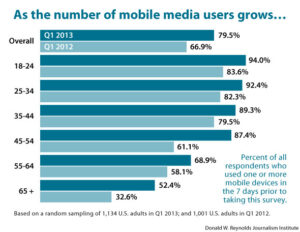
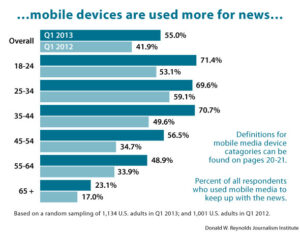
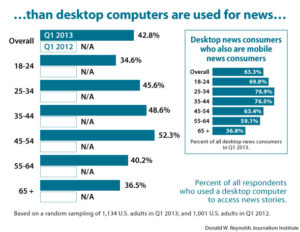
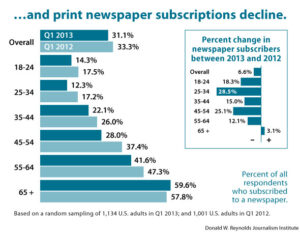
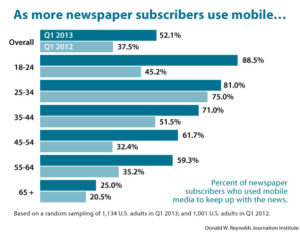
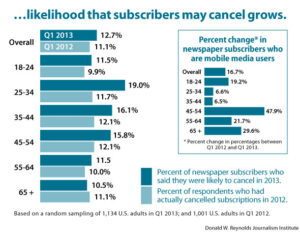
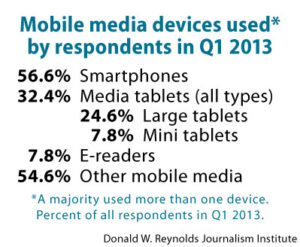
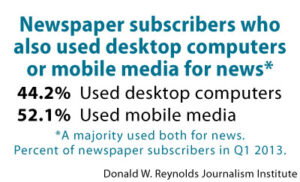
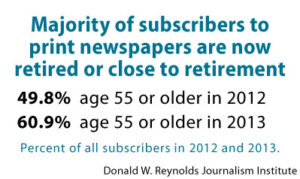
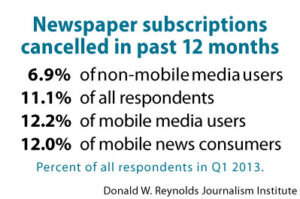
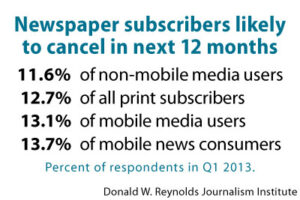
Comments